- Home
- General Info
- Solutions
- Overview of Cheque Clearing and Processing
- Cheque Truncation System (CTS)
- Cheque Fraud Solution
- Cheque Book Issuing Systems
- Cheque Entry Solutions
- Cheque Encoding Solutions
- Outward Clearing Solution
- Automated Cheque Settlement
- Inward Clearing Solutions
- Cheque Archival Solutions
- Teller Cheque Deposit Solution
- Products
- Support
- Company
Overview of Cheque Clearing and Processing
Overview of Cheque Clearing and Processing
Cheque clearing is basically a process in which interbank cheques are processed for settlement. Cheque clearing is usually done by an authorised clearing house or, in some countries, by the central bank. Electronic cheque clearing allows for faster settlement, up to one day settlement in some countries. In other countries, however, cheque settlement may take longer due to more intricate procedures such as upstream to downstream processing of physical documents, in this case the paper cheque.
Regardless of the different procedures and settlement time, at the end cheque clearing and settlement processes facilitate financial transactions between participating institutions, especially banks.
There are several mechanisms with which cheque clearing / cheque settlement may be conducted in a country. Some countries may adopt a particular cheque clearing mechanism, while other countries may have preferred a different business flow. Nevertheless, here are cheque clearing and settlement procedures you may find:
- Electronic clearing system with document to follow
- Electronic clearing system with document to follow (with third party cheque processing centre)
- Electronic clearing system with third party cheque processing centre
- Image clearing system with document to follow
- On-us / own cheque truncation\
- Traditional on-us / own cheque processing
- Cheque truncation system
1. Electronic clearing system with document to follow
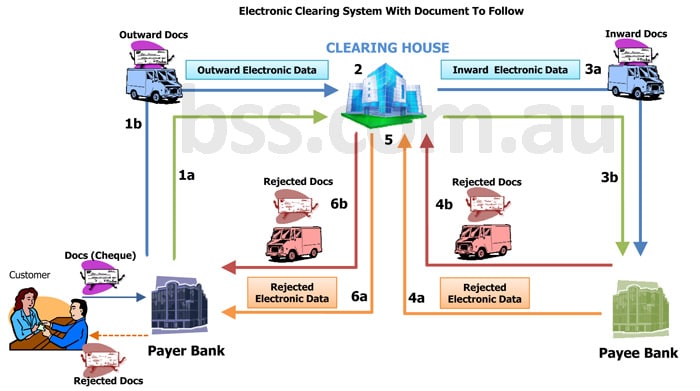
Electronic clearing and settlement of interbank cheque has been common in many countries around the world. Numerous financial institutions have customised their business processes in order to create electronic transaction data for interbank transactions. Although, there is no doubt that clearing and settlement of transaction data electronically between institutions has expedited the whole inter-institution process and produced faster outcome, numerous clearing systems worldwide still require presentment of the original physical cheque as “document to follow” for proof of transaction in this interbank data exchange and settlement. This results in delay in interbank financial settlements.
Literally couriered to follow the exchange of electronic transaction data from one clearing institution to another, interbank cheques are delivered as outward documents from payer bank to the clearing house. At the clearing house, they are sorted according to originating or payee bank and, subsequently, sent to the corresponding bank as inward documents for verification against the electronic data, validity of accounts and sufficiency of fund. Approved cheques will then be stored at the payee bank, while the rejected ones will be returned to the payer bank, via the clearing house, together with the electronic data and reasons of rejection.
a. Benefits of implementing this system
Presentment of original cheques as document to follow in interbank clearing and settlement system has not only served as reliable proofs of transaction, but they also facilitate dual control of validity and authenticity of transactions. With both electronic data and original paper cheques available for verification in every involved institution, no party will be left with questionable transaction status—this ensures complete accountability in financial transactions.
b. Questions to ponder
Implementation of such clearing system has presentedseveral issues which, among others, include:
- How can banks create electronic data format that is acceptable and can be processed by all participating institutions with as minimum effort as possible?
- How can clearing institutions exchange this highly sensitive transaction data effectively?
- How to practically read and sort thousands or millions of document to follow and, at the same time, automatically verify the corresponding electronic data?
- More importantly, is there a way to reduce reliance on the relatively risky, costly and time consumingprocess of exchanging document to follow?
2. Electronic clearing system with document to follow (with third party cheque processing centre)
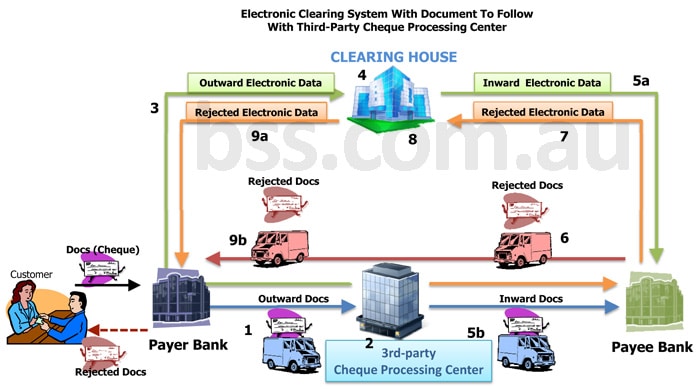
In order to eliminate the hassles of dealing with thousands to millions of paper cheques and converting transaction data to the prescribed format of data exchange, financial institutions in some countries have outsourcedthe processing of both physical cheque (document to follow) and conversion of electronic data to third-party cheque processing centre (CPC).
a. Benefits of implementing this system
With this mechanism, both payer bank and clearing house are spared from having to invest on bulky cheque processing equipment, nor do they need to spare extra resources to supervise reading and sorting of mounts of documents or perform laborious data entry. All they have to deal with is transfer and settlement of electronic data, which is usually done semi-automatically with computerised application and minimum user intervention.
At the end of the day, payee bank will still receive the original cheques as document to follow and, therefore, isstill able to verify the electronic data against those documents sent from CPC. Approved cheques will be archived internally, while rejected cheques will be sent back to payerbank via CPC. The payer bank will in turn receive both the rejected paper cheques and corresponding rejects of electronic data from CPC and clearing house.
b. Questions to ponder
Implementation of such clearing system has presented several issues which, among others, include:
- How can clearing institutions exchange highly sensitive transaction data effectively?
- How to minimise investment on cheque processing and exchange of physical cheque considering the decline of cheque usage worldwide?
- More importantly, is there a way to reduce reliance on third party for processing and exchange of high security documents such as interbank cheques?
3. Electronic clearing system with third party cheque processing centre
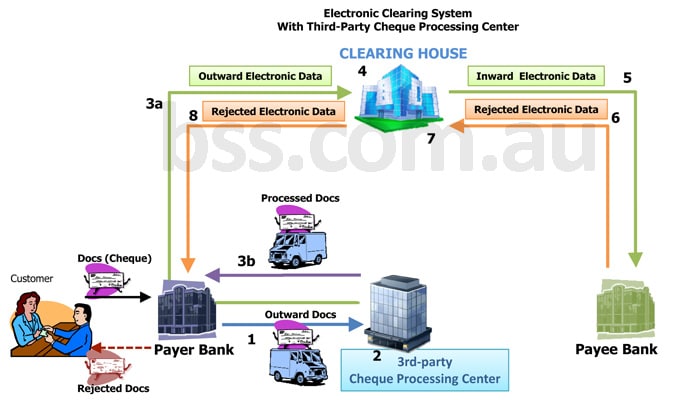
To eliminate the risk of transporting and processing physical cheque from one institution to another, document to follow is no longer applied in some countries. In this mechanism of clearing, payer bank is usually the only party dealing with third party cheque processing centre for processing of cheques and generation of electronic transaction data. Upon processing, original chequesare returned to payer bank and they stop there for archival.
Only interbank electronic data is exchanged among clearing institutions and settled within them. Similarly, the only reject format returned to payer bank is the electronic data.
a. Benefits of implementing this system
This system has definitely cut down transportation cost and risk incurred from delivery of documents to follow to multiple parties. Moreover, with this system, banks are no longer required to send and receive original paper cheques to and from either the clearing house or other banks. In addition, there is potentially no doubt that this system may minimise the time required for interbank financial transactions because the only transportation of paper cheques required is only between banks and CPC.
b. Questions to ponder
Implementation of such clearing system has presented several issues which, among others, include:
- How can each clearing institution obtain accurate proof of transaction without exchange of document to follow?
- What will payee bank refer to in case of dispute in future?
- More importantly, is there a way to minimise reliance on third party for processing and generation of electronic data for high security documents such as interbank cheques
4. Image clearing system with document to follow
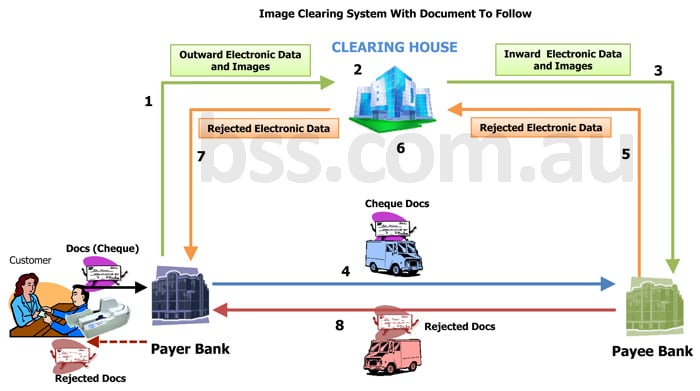
To provide proof of transaction for each clearing institution including the clearing house, yet minimise transportation of paper cheques across multiple institutions, payer banks in some countries have adopted digital solution that scan physical cheques they receive and send the images along with electronic data to clearing house and subsequently to payee bank. Upon processing and delivery of outward cheque data and images, original cheque is usually couriered directly to payee bank as document to follow, without stopping over at clearing house.
a. Benefits of implementing this system
This system provides double benefits of provision of proof of transaction to every clearing institution, in the form of digital copies of cheques, as well as corresponding document to follow to payee bank for dual control in verification and authentication of transaction. In addition, the reduced number of parties involved in handling original cheques would definitely save a significant amount of time required in settlements of interbank transactions.
b. Questions to ponder
The issue is, nevertheless, there is still cost and investment involved for sorting, transportation and storage of paper cheques. The question is:
- How do institutions completely eliminate the risk and investment involved in processing, transporting and storage of physical cheques?
5. On-us / own cheque truncation
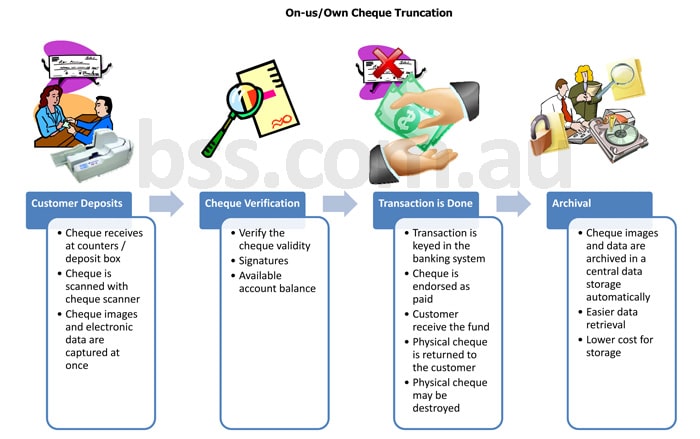
One way to address the issue on archival of physical on-us cheques is by implementing cheque truncation. Upon deposit of cheque over the counter or in cheque deposit box, teller or back office staff can scan cheque images while capturing transaction data at the same time. Processing of cheque can immediately be performed using solely the electronic data and cheque images. In other words, original cheques – no longer required in the process – can be returned to customers or payees after being endorsed. Alternatively, paper cheques can also be destroyed upon payment of cheque fund.
a. Benefits of implementing this system
In short, since storage of paper cheques is no longer required, banks do not need to make investment for special storage facility nor for transport and handling of cheque archives. Electronic cheque data and their images can be stored in digital storage space such as computer server, which implies low cost storage and much less physical space. In addition, with computerised archival of both cheque data and images, system archival is guaranteed and data retrieval can be relatively easy. Electronic archive of cheques can even be stored centrally in the head office and be made accessible from all bank branches.
Last but not least, by digitalising proof of transaction computerised integration with verification system such as signature verification system becomes highly feasible.
b. Questions to ponder
The questions are, however:
- Is there a solution that delivers such optimum archival and verification benefits available in the market?
- Which solution is most effective both function-wise and cost-wise?
6. Traditional on-us / own cheque processing
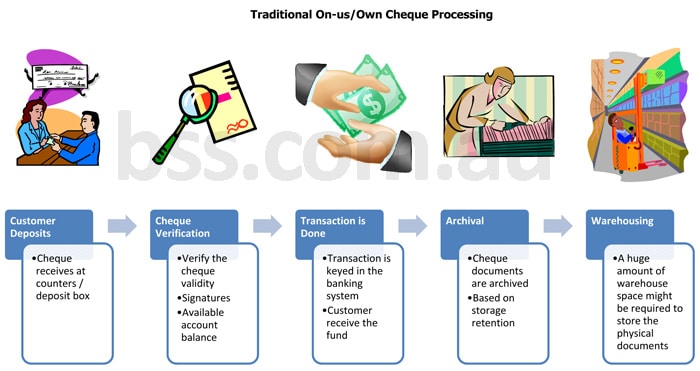
On-us cheque is normally cleared over the counter. This kind of cheque originates from the same bank where cheque was initially deposited and, therefore, it does not require going through interbank cheque clearing before it can be settled. Usually, customer, in this case payee, can obtain the fund almost immediately or latest within the same business day. This is because the payer’s account is also in that same bank.
Once cheque is cashed in over the counter, or deposited into cheque deposit box, it will go through various verification stages internally ensuring that not only cheque and account are valid but fund is available. The process of verification itself is generally tedious; often staffs have to send or fax a copy of the original to issuing branch in order to verify customer’s information and signature.
Upon verification from the corresponding branch, teller or authorised back office staff will subsequently key in the transaction into the core banking application and process it to facilitate withdrawal of cheque amount.
a. Questions to ponder
However, processing of on-us cheque highlights significant issues, including bulk storage of paper cheque and time-consuming verification. To resolve this issue, institutions will have to address questions including:
- How to minimise the risk of wear and tear of cheque archives, especially considering multiple handling done manually and long-term storage of paper cheque?
- How to eliminate the need and cost of transporting cheque to special storage facility and, better still, cut down investment on such facility?
- Is there a solution that is reliable and responsive enough to make verification of cheques and customers’ data especially signatures become practical and least time-consuming?
- More importantly, how to create an archive library that is systematic enough such that retrieval of cheque archive becomes significantly practical and cost effective, especially for banks with multiple branches?
7. Cheque truncation system
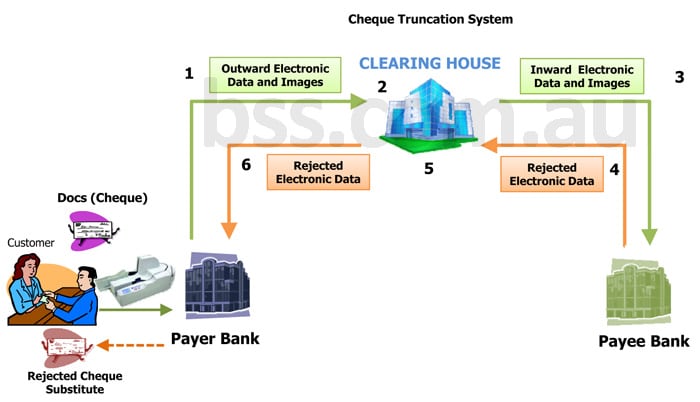
As the use of cheques has been deemed to be constantly declining worldwide, especially due to the booming presence of various electronic payment methods, cheque clearing using first-point truncation system has been massively considered by numerous finance regulatory bodies across the globe. Implementation of this method will not only totally eliminate the need of transporting physical cheques as document to follow across institutions, but it will also minimise investment required for handling and storing of cheque.
In first-point cheque truncation system, interbank cheques are scanned over the counter or at the back office. This process will not only produce digital images of cheques but also generate electronic transaction data. Additional work that may need to be performed manually at the payer bank is strictly limited to data entry and repair, before electronic cheque data and images are sent to clearing house via outward process.
a. Benefits of implementing this system
Being electronic, both cheque data and images can be automatically and instantly settled and sorted by computerised system at the clearing house and directly transferred to corresponding payee or paying bank. The process of data matching and verification in any of the institutions will be done against the digital images instead of paper copies.
To sum up, not only is each clearing institution in possession of proof of transaction and able to perform dual control in verifying and authenticating financial transactions, but they will also save significant amount of money and time by doing away with the need of processing, transportation and storage of physical cheque. Yet, more importantly, electronic cheque archives can be easily backed up and retrieved at any time, eliminating the risk of data lost.
b. Questions to ponder
Considering this first-point truncation system being the most feasible solution in response to today’s trend of cheque use, institutions are presented with the following questions:
- What is the best, most effective cheque truncation solution available in the market?
- How simple can cheque truncation and data entry process be with this solution?
- How competent is the solution provider in handling high security data processing and management?
- Is the solution provider highly experienced in inter-institution and nationwide projects?
- More importantly, how quickly adaptable is the solution and the solution provider in response to the ever-changing trend in cheque processing and settlement?